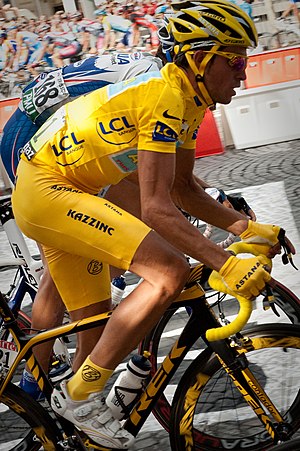
Is Alberto Contador really positive for Clenbuterol?
William Fotheringham reports in The Guardian today that Alberto Contador has been provisionally suspended after positive test taken during the second rest day of the 2010 Tour de France (Alberto Contador provisionally suspended after positive test).
Apparently traces of the banned drug Clenbuterol were found in a urine sample: Clenbuterol is a bronchodilator used by asthmatics (clinically) and illicitly by athletes to improve breathing and enhance weight loss (presumably the latter's not an issue in a Grand Tour). So Contador has been 'provisionally suspended', whatever that means. Interestingly Fotheringham goes on to write:
Contador was notified of the finding on 24 August, his spokesman said yesterday. A statement from cycling's governing body, the International Cycling Union, issued this morning said that the concentration of clenbuterol found in Contador's urine was 50 picograms*, 400 times less than the threshold required by a World Anti-Doping Agency accredited laboratory, and that investigations were in progress. [*50 picograms = 0.05 nanograms = 0.00005 micrograms = 0.00000005 milligrams = 0.00000000005 grams]Leaving aside the observation that 50pg is not actually a concentration but an amount, why is there a case to answer here if the amount detected is 400 fold less than required by a WADA accredited laboratory (presumably to call a positive). What, one wonders, is the UCI's doping limit for clenbuteral? And furthermore, presumably Contador had tests on other days of the Tour - if he was doping, wouldn't clenbuterol have shown up in those? A WADA representative is quoted as saying
The issue is the lab has detected this. They have the responsibility for pursuing. There is no such thing as a limit where you don't have to prosecute cases. This is not a substance that has a threshold.Which kind of contradicts the earlier statement in the article. This really comes across as a mysterious case. I await a UCI statement about the matter. From my science-based viewpoint, there have to be limits below which sanction will not be taken: as analytical methods improve in sensitivity, one might expect to see all sorts of false positives, ranging from contamination to just confused results. What should happen if an athlete recorded 0.5pg? Or less - maybe 0.5 femtograms (which is 0.0000000000000005 grams - I think - all those zeros get confusing! 50 pg is usually written as 50 x 10e-12, 0.5 fg would be 0.5 x 10e-15) I guess this one's going to run for a bit. I read an article in the journal Science around the time of the Landis positive, which made for interesting reading concerning the possibility of a false positive occurring during multiple tests of an individual during a three week event: this concerned the EPO test, which by it's nature has an arbitrary cut-off for a positive to be called. Other relevant posts in this blog
Stay Informed
When you subscribe to the blog, we will send you an e-mail when there are new updates on the site so you wouldn't miss them.


Comments